
There are millions upon millions of blogs available today, and many of them are hosted on dedicated blogging services. These kinds of services have been around for a long time, with pioneers like Blogger paving the way for WordPress.com and more recent arrivals like Tumblr.
One of the main benefits of using a blogging service is that they make blogging easy. There’s no need to deal with traditional hosting. You blog, the blogging service keeps your content available online.
In theory, blogging services should also be able to make your blog more reliable since they have a lot of servers at their disposal, often spread across multiple data centers. If your blog gets flooded by traffic (usually a good thing), a blogging service has a much better chance handling it since your traffic is just a drop in the ocean for them. Had you been on a single server (or even a shared one), your site might not have coped.
With that in mind, we decided to test five of today’s most popular blogging services to see how reliable they actually are. You may remember that we did this last year as well, so we’ll be able to see how and if anything has changed since then.
Which services we tested, and how
We included Blogger, WordPress.com, Typepad, Tumblr and Posterous in this survey. There are other blogging services out there as well, but we focused on these since it’s quite likely that if you’re blogging today, you’re on one of these five.
For each blogging service, we monitored the availability of the homepage and four individual blogs, so we could see how the service as a whole performed. For the details, check out our “Methodology” section at the bottom of this post.
The tests were performed once a minute over a period of 11 months, January 1 – November 30, 2011. We used the Pingdom site monitoring service (of course, it’s what we do), performing tests from multiple locations in North America and Europe.
Key findings
- The most reliable service is… Without a doubt, Blogger. The service had almost no downtime to speak of, just a few minutes over the entire year. Google’s blogging service has been consistently reliable and actually placed top in our survey last year as well. WordPress.com and Typepad deserve honorable mentions, with less than two hours of downtime across the entire year, which is also very good.
- Tumblr still has some reliability issues. On the upside, it does seem like the service has improved its availability since last year, and hasn’t suffered from the same kinds of disastrously long outages as it did in 2010.
- Blog uptime varies even within the same service. As we observed last year, the amount of downtime can differ significantly between blogs on the same service. This is universally true across all of the services we monitored, although the differences were more dramatic in some cases.
Of course, when we say “the entire year” in this post, we really mean the first 11 months since that is the data we used for this survey.
Blogging service downtime
The main point of this survey was to find out which blogging services are the most reliable, i.e. have the least downtime. When you run a blog, you normally don’t want your visitors to be met by an error page, or not able to load the page at all.
Since this survey covers such a long time span, 11 months, we believe it should give a very fair overview of the amount of downtime each service had. And to be extra sure these numbers would be representative, we monitored several blogs per service. What you see in the chart here below is the average blog downtime per service.
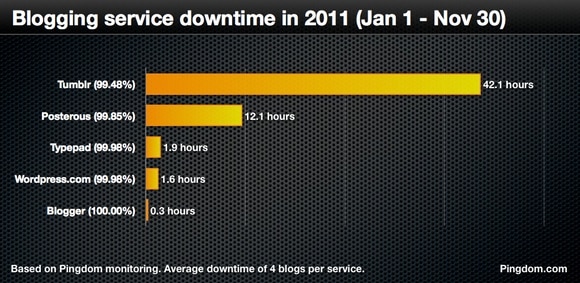
As you can see in the chart, the average Tumblr blog suffers from significantly more downtime than blogs on any of the other services included in this survey.
On the other end of the spectrum you have Blogger, WordPress.com and Typepad, which were the most reliable services by far. They all had less than two hours of downtime over the 11 months of this survey.
If you run that down to average blog downtime per month you get:
- Tumblr: 3 hours and 50 minutes per month
- Posterous: 1 hour and 6 minutes per month
- Typepad: 10 minutes per month
- WordPress.com: 9 minutes per month
- Blogger: 1.5 minutes per month
Blogger actually had so little downtime that it managed an uptime of 99.998%. Since we rounded everything to two decimals in this survey, you see 100.00% uptime for the service. To almost reach “five nines” over such a long period of time is highly impressive.
Now on to taking a more detailed look at the individual blogging services.
Tumblr overview
- Tumblr homepage uptime: 99.62%
- Average Tumblr blog uptime: 99.48%
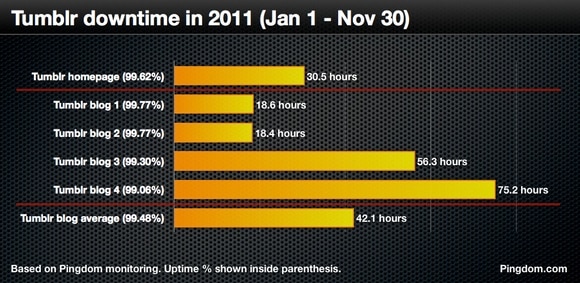
The single longest outage for a Tumblr blog we detected was 3 hours, but three of the four blogs we monitored had no outage lasting longer than 1 hour and 37 minutes.
Although Tumblr placed last in this survey, it should be noted that the service has undergone a significant improvement in terms of reliability since our survey from last year. To give you an example, Tumblr had more downtime in two months in 2010 than it’s had the entire year in 2011 (well, the first 11 months).
Tumblr has also managed to avoid any major incidents like the ones they had last year, usually resolving any downtime issues relatively quickly. Last December, Tumblr was at one point offline almost 24 hours straight. Nothing even close to that has happened in 2011.
One mitigating circumstance is that Tumblr is probably the fastest growing of these services, which does tend to come with its own set of scalability problems. To give you an idea: A year ago the service had 11 million blogs. Today it has more than 37 million blogs.
Posterous overview
- Posterous homepage uptime: 99.82%
- Average Posterous blog uptime: 99.85%
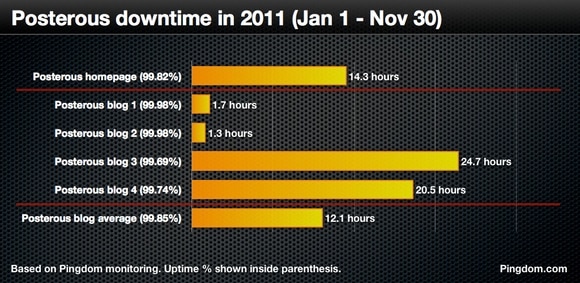
As you can see in the chart, the result for Posterous was a mixed bag.
The standouts in terms if downtime were blogs using custom domains (blog 3 and 4, see “Methodology” at the bottom of this article). We noticed this difference for Posterous last year as well. This downtime doesn’t appear be directly DNS-related, which could otherwise have explained it to some extent. (Involving your own domain name introduces another link in the chain that can break, which could potentially result in more downtime.)
This was also reflected in the length of individual downtimes we detected. One custom domain blog was unavailable for almost eight hours at one point, while the other custom domain blog was at one point unavailable more than four hours. The blogs not using custom domains had much shorter outages, none lasting more than 10 minutes.
It could still be a coincidence, and maybe the specific blogs we monitored would show these differences regardless, but it’s noteworthy nonetheless.
(If you work at Posterous and would like more information from us, please feel free to contact us and we’ll help as much as we can.)
Typepad overview
- Typepad homepage uptime: 99.97%
- Average Typepad blog uptime: 99.98%
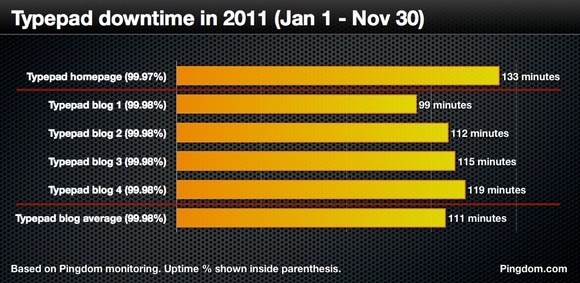
The longest single outage we detected for Typepad was 36 minutes.
There really isn’t all that much we can say about Typepad’s results, other than that they were very respectable. Having only a couple of hours of downtime over the course of 11 months is a job well done.
WordPress.com overview
- WordPress.com homepage uptime: 99.99%
- Average WordPress.com blog uptime: 99.98%
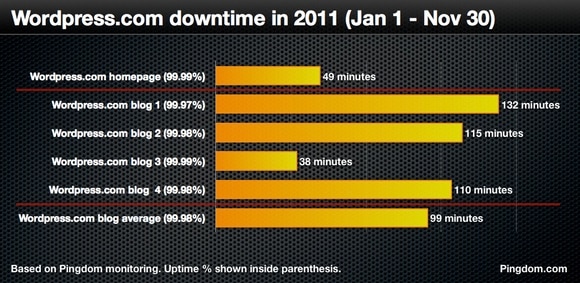
No single outage for a WordPress.com blog exceeded 47 minutes.
There isn’t much to say about this either. The results for Automattic’s hosted WordPress service are very solid, with very little downtime over the 11-month period of this survey. Again, job well done.
Blogger overview
- Blogger homepage uptime: 100.00%
- Average Blogger blog uptime: 100.00%
The downtime for Blogger’s blogs ranged between 10-15 minutes for the entire 11-month period of the survey, barely more than a minute per month on average.
Due to this, we decided to skip the chart for Blogger because it simply wouldn’t have been very interesting (this year again, last year’s shorter, two-month survey came up with zero downtime). As we pointed out earlier in this article, there was so little downtime that when rounded to two decimals, like we’ve done here, it ends up as 100.00% (instead of 99.998%, if we’d used three decimals). Google is doing a great job.
Conclusion
Of course reliability is but one of several factors you want to take into consideration when picking a blogging service. There’s everything from personal preference, your general blogging needs, the community, the interface, and much more to take into consideration.
That said, when it comes to sheer blog hosting reliability, the results are as follows:
- Blogger
- WordPress.com
- Typepad
- Posterous
- Tumblr
The reliability ranking here turned out to be something of a repeat from last year’s survey. Blogger is still the reliability champion, followed by WordPress.com and Typepad, in that order.
We should mention that having no downtime whatsoever is not realistic in the long run. Although no one likes it, downtime is simply a fact of life on the Internet. The trick is keeping it to a minimum, which is often easier said than done.
For a blogging service, we think the aim should be to deliver at least 99.9% uptime in the long term, which allows for 43 minutes of downtime per month on average.
This is why Google’s close to perfect score for Blogger over such a long period of time is so impressive. We have no doubt that at some point Blogger will suffer from some kind of notable outage, but Google has done an admirable job so far so it may take quite some time until that happens. And when it does happen, Google does have a good track record for resolving such issues considering the size of its infrastructure and the amount of services they offer. All we can do is congratulate Google on their excellent work keeping Blogger available to this degree.
Although Tumblr ended up in last place in this survey, it does seem to be on the right track. It may take the service a while to truly catch up with its growing popularity, though. Tumblr is, as the saying goes, a victim of its own success at the moment.
Methodology:
We monitored five websites for each blogging service: the homepage, and four individual blogs. The homepage was not included in any average.
Since people can put their blogs on either a subdomain to the service, or use their own domain name, we picked two representatives of each for each service. In the charts above, blog 1 and 2 for each service are on subdomains (e.g. example.tumblr.com), while 3 and 4 are on custom domains (e.g. www.example.com). Since potential DNS issues with the custom domains would be outside the control of the blogging services, we did our best to exclude any downtime caused by this.
This is what we count as “down”: If the blog loads so slowly we can’t load the HTML page within 30 seconds. If the server responds with an HTTP error code (5xx or 4xx). Or, of course, if the site is completely unreachable.
Monitoring was done from Pingdom’s 30+ monitoring locations spread over North America and Europe, with tests performed every minute. To avoid the risk of false positives due to local network issues, our monitoring system always performs an extra test from a second location before downtime is counted. The monitoring was done during January 1 – November 30, 2011.



























